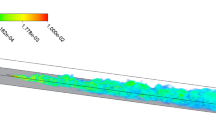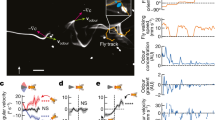Abstract
A model is presented that suggests that the optimal strategy for an animal walking or crawling on a substrate while searching for the source of a chemical carried by a shifting wind or current may be to move upwind (or against the current). The requirements are that (1) the current direction fluctuates rapidly within a range that exceeds 30 ° on both sides of the mean direction, and (2) the searching animal can move accurately up- or downwind and, once within the influence of the chemical plume, can move efficiently to the source. Under these conditions, an upwind search is shorter (on the average) by 0.9–0.3 of the range of influence of the chemical stimulus. Thus, this strategy is relatively more important when the total search path is short, i.e., when sources are typically close by. The mean length of the downwind search path is given by 〈L d 〉=d +r[(1/E) + cos α]/2 and the upwind search path by 〈L u 〉=d +r[(2/E) − (α/sin α) − cos α]/2 whered is the starting distance up- or downwind of the source,r is the range of stimulus influence,E is the efficiency with which the searcher moves to the source within the influence of the plume,a is the angle of the maximum extent of wind direction from the mean, and the average, 〈 〉, is taken over all starting positions across the wind direction that lead to search paths that intercept the area swept by the plume.
Similar content being viewed by others
References
Cardé, R.T. 1981. Precopulatory sexual behavior of the adult gypsy moth, pp. 572–587,in C.C. Doane, M.L. McManus (eds.) The Gypsy Moth: Research Toward Integrated Pest Management. Technical Bulletin 1584. U.S. Department of Agriculture, Washington, D.C.
CardÉ, R.T. 1984. Chemo-orientation in flying insects, pp. 111–124,in W.J. Bell and R.T. Cardé (eds.) Chemical Ecology of Insects. Sinauer Associates, Sunderland, Massachusetts.
Dusenbery, D.B. 1989a. Efficiency and the role of adaptation in klinokinesis.J. Theor. Biol. 136:281–293.
Dusenbery, D.B. 1989b. Ranging strategies.J. Theor. Biol. 136:309–316.
Dusenbery, D.B. 1989c. Calculated effect of pulsed pheromone release on range of attraction.J. Chem. Ecol. 15:971–977.
Dusenbery, D.B. 1989d. Optimal search direction for an animal flying or swimming in a wind or current.J. Chem. Ecol. 15:2511–2519.
Elkington, J.S., andCardé, R.T. 1983. Appetitive flight behavior of male gypsy moths (Lepidoptera: Lymantriidae).Environ. Entomol. 12:1702–1707.
Elkington, J.S., Schal, C., andCardé, R.T. 1987. Pheromone puff trajectory and upwind flight of male gypsy moths in a forest.Physiol. Entomol. 12:399–406.
Finch, S., andSkinner, G. 1982. Upwind flight by the cabbage root fly,Delia radicum.Physiol. Entomol. 7:387–399.
Janzen, D.H. 1984. Two ways to be a tropical big moth: Santa Rosa saturniids and sphingids.Oxford Surv. Evol. Biol. 1:85–140.
Kalmus, H. 1942. Anemotaxis inDrosophila.Nature 149:405.
Linsenmair, K.E. 1969. Anemomenotaktische Orientierung bei Tenebrioniden und Mistkäfern (Insecta, Coleoptera).Z. vergl. Physiol. 64:154–211.
Linsenmair, K.E. 1973. Die Windorientierung laufender Insekten.Fortschr. Zool. 21:59–79.
Pline, M., andDusenbery, D.B. 1987. Responses of plant-parasitic nematodeMeloidogyne incognita to carbon dioxide determined by video camera-computer tracking.J. Chem. Ecol. 13:873–888.
Sabelis, M.W., andSchippers, P. 1984. Variable wind directions and anemotactic strategies of searching for an odour plume.Oecologia 63:225–228.




